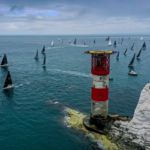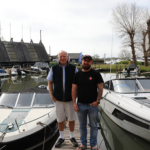British Marine has released its latest Key Performance Indicators report for the 2021/22 financial year, detailing a range of economic trends and statistics from across the UK leisure, superyacht and small commercial marine industry, which confirm that the marine industry enjoyed a successful post pandemic bounce back.
“It is encouraging to see that the marine industry made a strong recovery post pandemic, prospering in both domestic and international markets and highlighting the significant contribution the sector makes to the UK economy. These results show that the industry was in a strong position as we headed into more uncertain economic times in 2022/23,” said Lesley Robinson, CEO, British Marine.
The report includes data on marine industry revenue, full-time equivalent employment and gross value added to UK GDP, alongside international trade and national figures for business and consumer confidence. It also covers consumer inflation, household leisure spending and a range of other economic metrics relating to the financial performance of the UK economy and marine industry.
The report uses aggregated data shared by members, combined with internal knowledge of non-members involved in the marine industry and Government statistics, to provide a robust economic audit of the industry.
Some of the key findings from the report include:
- The UK marine industry bounced back from a year plagued by pandemic disruptions with like-for-like revenue growth of 25% in 2021/221. Total industry revenue was estimated at £4.23 billion – or 6.5% above its pre-pandemic level (2019/20 financial year).
- The industry’s direct GVA contribution to UK GDP is estimated to have grown 27% to £1.57 billion in 2021/22, showcasing the significant added value that marine businesses create for the UK economy2.
- If we add to this the additional, indirect and induced economic contribution rendered by marine businesses through their employee and supply chain spending, as well as the hospitality spending of boating and watersports participants, the combined economic contribution of the marine industry is estimated to total £6.80 billion3.
- With the re-opening of international markets post-pandemic, UK marine exports made a strong recovery in 2021/22, growing 13% to £1.22 billion, powered by the sale of UK-made boats. Sailboat exports grew 40% to £116 million, rigid inflatables increased 48% to £30 million and overseas powerboat sales were up 7% to £574 million.
- With domestic demand powering industry growth, imports also saw a robust increase in 2021/22, growing 8% year-on-year. Sales were driven by local demand for powerboats, with inboard and outboard powerboat imports up 32% to £109 million, rigid inflatables up 66% to £39 million and outboard engines up 40% to 22 million.
- Full-time equivalent jobs are estimated to have increased 5% to 38,100 in 2021/22 with early career training also seeing an increase as the industry’s profile grows. Government statistics show that apprenticeship starts have grown 36% (to 4,100) since 2019/20. This has been driven by an increase in post-pandemic manufacturing, with boatbuilding and marine engineering apprenticeships up 27% and 28%, respectively.
- This post-pandemic recovery has been driven by continued hunger for new and used boats at home and abroad, as well as marine equipment and accessories and ‘staycation’ boating experiences, as Britons continued to look to recreation on the water as an antidote to pandemic-related issues. These sectors experienced estimated revenue growth over the last year of 32%, 34% and 43%, respectively, their highest on record.
- Of course, economic events have changed rapidly since the end of the 2021/22 financial year in April, with high inflation and deteriorating consumer spending power eroding this boom. UK consumer confidence sank to its lowest index score on record in October 2022 (91.5)4, with both consumers and businesses hit by a ‘cost of living’ crisis that has pushed the UK to the brink of recession. According to the latest Government figures (ONS), monthly GDP year-on-year growth slumped from 11.6% in January 2022 to 0.02% in January 2023.
- Whilst the marine industry has been resilient through this latter period (January 2022-January 2023), generally outperforming the wider UK economy, it has not been immune to the financial challenges now affecting UK businesses. British Marine’s latest sentiment survey (December 2022) indicates that the share of marine businesses seeing quarterly sales growth (year-on-year) dropped from 52% in Q1 2022 to 29% in Q4 2022. However, despite the decline in sales growth over the last six months, marine business confidence remained steady, with 49% of British Marine members reporting in December that they were still optimistic about their prospects going into 2023, and that is double the number of businesses pessimistic about their future.5
“Overall, the report is reassuring however we must remain mindful that these figures related to 2021/2022 and the impact of the current ‘cost of living’ crisis and the overall financial challenges affecting many UK businesses may well have a future impact on the sector,” Lesley concluded.
British Marine members can access the full report for free by visiting: https://mymembership.britishmarine.co.uk/resources/publications/posts/2023-7/march/key-performance-indicators-for-the-leisure-superyacht-small-commercial-marine-industry-2021-22/
[1] All growth figures published in this report have been calculated based on “like-for-like” comparisons of British Marine member companies’ financial data for the 2020-21 and 2021-22 fiscal years.
2 Simply put, gross value added (GVA) is a sector or industry’s contribution to GDP. It is the unique “value added” created for the economy by the use of labour and capital attributable only to that sector or industry. It is calculated by taking that sector or industry’s gross output and subtracting all the resources used in the production of that sector or industry’s goods and/or services that are attributable to any other sector or industry.
3 According to a recent study commissioned by British Marine, spending by boating and watersports participants on hospitality items (like food, drink and entertainment) whilst participating in their activity, generated £4.7bn in gross value added (GVA) in 2020. British Marine / Canal & River Trust, Measuring the economic, social and wellbeing value associated with inland and coastal boating (2021).
4 Any index figure above 100.0 is considered positive, any figure below is considered negative. The lowest score prior to the pandemic was 95.0, recorded in December 2008 at the height of the sub-prime financial crisis.
5 Overall, 49% of respondents remained optimistic about their business’s prospects, 29% were undecided and 22% indicated they were pessimistic about the future.



















